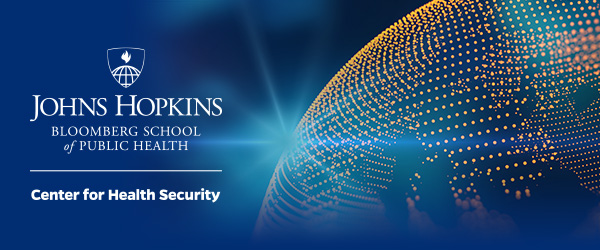

COVID-19 Situation Report


Weekly updates on COVID-19 epidemiology, science, policy, and other news you can use.
Click to Subscribe

Announcements
CALL FOR PAPERS Early detection of biological threats, whether naturally occurring or manmade, is critical. Threat agnostic approaches, which do not rely on determining the identity of the agent or pathogen, show early promise. In 2023, the Johns Hopkins Center for Health Security journal, Health Security, will issue a special feature that considers threat agnostic approaches to biodefense and public health. We encourage submissions of original research articles, case studies, and commentaries that explore policy gaps, data and data analysis, and implementation, among potential topics. The deadline is March 31, 2023. For more information, visit: https://www.centerforhealthsecurity.org/our-work/journal/call-for-papers/call-for-papers.html
NOTE In this newsletter, we include hyperlinks to original sources as a way of citation and for further information. Several of the sources we link to are accessible only to subscribers. We apologize for any inconvenience.

In this issue
> World marks 3rd anniversary of COVID-19 pandemic; news outlets, experts reflect on lessons learned, actions needed to prepare for next health emergency
> WHO calls COVID-19 origin investigations scientific, moral imperative; US Congress passes bill calling for declassification of intelligence information
> COVID-19 pandemic exacerbated health workforce shortages, WHO says, calls for health worker migration agreements
> 4 vaccine doses provide protection against severe COVID-19, restore waning immunity; US FDA authorizes bivalent booster for youngest children but mum on spring boosters for individuals at high-risk
> US maternal mortality climbed significantly during pandemic, with communities of color more dramatically impacted
> Studies, articles show pandemic’s negative impacts on health and wellbeing of children, adolescents
> US FDA briefing document supports Paxlovid use in high-risk COVID-19 patients ahead of expert meeting to discuss full approval
> What we're reading
> Epi update

World marks 3rd anniversary of COVID-19 pandemic; news outlets, experts reflect on lessons learned, actions needed to prepare for next health emergency
March 11 marked 3 years since the WHO declared COVID-19 a pandemic. While most nations have relaxed their mitigation measures, the virus continues to kill thousands of people each week worldwide and likely will be with us for the foreseeable future. This week, several news outlets—including Bloomberg, Scientific American, US News & World Report, Wall Street Journal, and Washington Post—reflected on pandemic responses and lesson learned, while other reporting—from The Atlantic, NPR, and Wall Street Journal—highlighted remaining questions about SARS-CoV-2 and what the future might hold.
Experts also are reflecting on lessons learned and a path forward, by answering reader questions in a newly launched New York Times limited-run newsletter, titled “The Next Pandemic,” and in related opinion pieces. In a New York Times commentary, Johns Hopkins Center for Health Security Director Dr. Tom Inglesby outlines 6 critical actions for pandemic preparedness, including quickly developing and vaccinating large numbers of people; facilitating the development and distribution of effective diagnostics; building and managing stronger stockpiles of high-quality protective gear; improving indoor air quality in buildings to diminish the risk of disease transmission; strengthening research oversight and lab safety; and streamlining and reinforcing public health agencies with better authority and funding. Most notably, policymakers must focus their efforts on preparing for the next pandemic by authorizing additional funding, he notes. In a separate New York Times opinion piece, Dr. Atul Gawande, assistant administrator for global health at USAID, says governments worldwide must refocus their health systems toward primary care in order to make a “real recovery from the pandemic—and be prepared for the next one.”
On March 23, Axios is hosting an event exploring how the US can improve its public health preparedness, with Bipartisan Commission on Biodefense Executive Director Dr. Asha M. George and Johns Hopkins Center for Health Security Director Dr. Tom Inglesby. Click here to learn more and register.

WHO calls COVID-19 origin investigations scientific, moral imperative; US Congress passes bill calling for declassification of intelligence information
Understanding the origin of COVID-19 by exploring all hypotheses constitutes both a scientific and moral imperative, to help prevent future outbreaks and “for the sake of the millions of people who died and those who live with long COVID,” WHO Director-General Dr. Tedros Adhanom Ghebreyesus said March 11 on Twitter, reiterating that the UN health agency remains committed to finding out how SARS-CoV-2 arose.
The day before, the US House voted unanimously to declassify all US intelligence information on the origins of the coronavirus, as part of US congressional efforts to investigate the pandemic’s origin. The US Senate passed the bill by unanimous consent on March 1. If signed into law by US President Joe Biden, the measure would require the declassification within 90 days of “any and all information relating to potential links between the Wuhan Institute of Virology and the origin of the Coronavirus Disease,” including information regarding research and other activities at the lab, such as whether any researchers fell ill. Biden has not indicated whether he will sign the legislation. If he does not, it will mark his first veto as president. In addition to Congress, 8 US government agencies are investigating the origin of COVID-19, but their findings remain divided and uncertain. Evidence from the scientific community largely supports the theory that SARS-CoV-2 arose from zoonotic transmission from an infected animal to a human.

COVID-19 pandemic exacerbated health workforce shortages, WHO says, calls for health worker migration agreements
At least 55 countries are facing serious healthcare worker (HCW) shortages, an existing situation exacerbated by workers leaving their home nations to seek better paid opportunities in wealthier nations amid the COVID-19 pandemic, the WHO said this week. The WHO health workforce support and safeguards list 2023 includes 8 additional countries since it was last published in 2020. African nations are the worst-hit, with 37 countries on the continent facing shortages of HCWs, threatening their chances of achieving the Sustainable Development Goal (SDG) of universal health care by 2030. The WHO list notes that the 55 countries have: 1) a density of doctors, nurses, and midwives below the global median (ie, 49 per 10 000 population), and 2) a universal health coverage service coverage index below a certain threshold. Though the list does not prohibit international HCW recruitment, it does recommend governments establish health worker migration agreements and implement the WHO Global code of practice on the international recruitment of health personnel (WHO Global Code) to ensure the international movement of health workers is ethically managed, supports those workers’ rights and welfare, and maintains health service delivery objectives.

4 vaccine doses provide protection against severe COVID-19, restore waning immunity; US FDA authorizes bivalent booster for youngest children but mum on spring boosters for individuals at high-risk
Four vaccine doses, including a primary 2-dose series and 2 booster shots, were the most effective way to protect against critical Omicron BA.5 infection, according to a large population-based study from South Korea published in JAMA Network Open. A 4-dose booster regimen was associated with higher protection against critical BA.5 infection, irrespective of a history of SARS-CoV-2 infection, according to the study, which highlights the importance of booster shots. Notably, subsequent boosters appear to restore waning immunity. In another study, published in Nature Communications, a fourth dose of monovalent mRNA vaccine restored strong protection against severe outcomes for at least 3 months after vaccination.
With these and other supportive findings, many countries, including the US, are looking to the future of vaccine schedules. The UK and Canadian governments plan to offer additional booster shots to people at high risk of severe COVID-19 this spring. In the US, the FDA has remained silent on the issue of spring boosters for those most at risk, creating frustration among a small number of people who do not want to wait until the fall to receive their next dose. Notably, only 16.3% of the total US population has received an updated bivalent booster. This week, the FDA amended the emergency use authorization (EUA) of the Pfizer-BioNTech bivalent COVID-19 vaccine to allow for a single booster dose of the vaccine in children aged 6 months through 4 years, to be administered at least 2 months after completion of the primary 3-dose series of the companies’ monovalent vaccine. So far, no US resident has had to pay for a COVID-19 vaccine dose, but that could soon change. Experts are concerned that if people have to pay an expected US$110-$130 per shot, they will forego the jabs that, based on ongoing research, continue to provide significant protection from serious COVID-19 disease.

US maternal mortality climbed significantly during pandemic, with communities of color more dramatically impacted
The rate at which people in the US died of medical conditions caused or aggravated by pregnancy increased from 23.8 deaths per 100,000 live births in 2020 to 32.9 deaths per 100,000 live births in 2021, with the burden of death disproportionately borne by communities of color, according to a report published today by the US CDC National Center for Health Statistics. In 2021, 1,205 women died of maternal causes in the United States compared with 861 in 2020 and 754 in 2019. These numbers represent an overall 40% increase compared to 2020, which itself had a 60% increase compared with 2019. Racial and ethnic disparities were particularly stark, with Black women experiencing 69.9 maternal deaths out of 100,000 births, compared to 26.6 maternal deaths per 100,000 births among White women. The US maternal mortality rate—the highest among high-income nations—increased for the third year in a row and the increases were significant in all race and Hispanic-origin groups and all age groups.
Though the report does not mention the pandemic, experts highlighted the likely role COVID-19 played in worsening the number of maternal deaths. They said there is a clear need to understand what factors, both social and biological, impacted the health of pregnant women during COVID-19. Additionally, scientists attribute some maternal stressors to the contextual factors of living through a tumultuous worldwide event, such as disrupting income or experiencing grief from deaths. Notably, social determinants of health are already an identified factor in the likelihood of having a preterm birth. Strong and lasting changes are needed to prevent these outcomes in future pandemic and non-pandemic scenarios and must be applied through an equity-focused lens in order to best serve expectant women.

Studies, articles show pandemic’s negative impacts on health and wellbeing of children, adolescents
Several new articles and studies highlight the severe, adverse impacts of the pandemic on the health and wellbeing of children and adolescents in the United States and around the world, as well as associated factors:
- A survey on adolescent mental health and substance use in Iceland documented increased depressive symptoms and worsened mental wellbeing for the first 2 years of the pandemic, as well as a decrease in alcohol intoxication that reversed after the easing of social restrictions. Parental social support and average sleep duration of 8 hours or more were significantly associated with better mental health outcomes and lessened substance use among adolescents.
- A survey of adolescents in cosmopolitan Singapore examining resilience during the pandemic noted that approximately half of the participants had normal resilience scores, while about one-third had low scores, according to the Brief Resilience Scale (59.6%/32.7%) and Hardy-Gill Resilience Scale (49.0%/29.0%). Chinese ethnicity, low socioeconomic status, and lower coping abilities related to school life, staying home, sports, and friends were associated with lower resilience scores.
- A Kaiser Health News article highlighted various studies showing how the effects of the pandemic and other recent events have heightened the gun violence crisis affecting children and adolescents. This is further echoed in a JAMA viewpoint published this week describing increases in pediatric all-cause mortality. Between 2019 and 2020, pediatric all-cause mortality increased 10.7% and increased an additional 8.3% between 2020 and 2021, with injuries (particularly from gun violence) and COVID-19 as the major culprits.
- A JAMA Network Open study noted that family financial disruptions were associated with a 205.2% [95% CI, 52.9%-509.0%] increase in perceived stress, 112.1% [95% CI, 22.2%-268.1%] increase in sadness, 32.9% [95% CI, 3.5%-53.4%] decrease in positive affect, and a 73.9 [95% CI, 13.2-134.7] percentage-point increase in COVID-19–related worry among a sample of 6,030 US children in late 2020. There was no association between in-person schooling disruption and mental health.

US FDA briefing document supports Paxlovid use in high-risk COVID-19 patients ahead of expert meeting to discuss full approval
A US FDA briefing document prepared by the Antimicrobial Drugs Advisory Committee and released this week addresses the question of whether or not Paxlovid is associated with COVID-19 rebound, a phenomenon wherein patients test positive or symptoms recur after initial recovery. The briefing document is meant to inform a panel of experts meeting today to determine whether to recommend Paxlovid for full approval for mild-to-moderate COVID-19 in adults at high risk of hospitalization or death. Since it received emergency use authorization (EUA) in 2021, more than 8 million people in the US have taken Paxlovid, which consists of a 5-day course of nirmatrelvir and ritonavir for COVID-19 treatment that has shown to reduce the chances of hospitalization, death, and experiencing long COVID.
The briefing concluded that Phase 2 and 3 clinical trials conducted by the drug’s manufacturer, Pfizer, support that Paxlovid’s benefits outweigh its risks. The document also acknowledged the COVID-19 rebound phenomena but concluded that rebound is likely a natural course of COVID-19 and likely not significantly associated with Paxlovid treatment. Notably, an ongoing clinical trial may indicate if re-treatment would aid patients who experience COVID-19 rebound, and another ongoing trial is investigating optimal treatment duration in immunocompromised patients. Data indicate that COVID-19 rebound rates range from 10-16% across patients, with no significant difference based on infection with either the Omicron or Delta variant. The FDA’s review of whether or not Paxlovid should receive full approval is expected to be completed in May this year.

What we’re reading
CHINA REOPENS BORDERS Following 3 years of border restrictions, China this week reopened its borders to foreigners, allowing nearly all types of visas to be issued as of March 14, including those for tourism. The move comes after the Chinese government last month declared victory over COVID-19 following an abrupt end to its strict mitigation policies in early December 2022. Travelers to China will still be required to take a COVID-19 test 48 hours before departure and note the results on their customs health declaration forms. The US State Department on March 10 urged US citizens to reconsider travel to China due to “arbitrary enforcement of local laws” and to exercise caution if traveling due to the risk of “wrongful detentions.”
PANDEMIC PROFITEERING In an open letter published March 11 by The People’s Vaccine, nearly 200 current and former presidents and ministers, Nobel laureates, faith leaders, heads of civil society organizations, health experts, business leaders, and celebrities call on governments to reflect on mistakes made in the response to the COVID-19 pandemic and “never again” allow “profiteering and nationalism” to hinder an equitable response to a global health crisis. The letter calls on world leaders to take 4 steps, including supporting a pandemic treaty at the WHO that embeds equity and human rights; investing in global common goods; moving to allow intellectual property waivers for vaccines, treatments, and diagnostics for COVID-19, as well as future pandemic diseases, to enhance knowledge and technology sharing; and investing in scientific innovation and manufacturing capacity in low- and middle-income countries. Work on the latter has begun, with the establishment of the mRNA vaccine technology transfer hub, but without sufficient funding, the long-term sustainability of the initiative is in question.
HEALTH OFFICIALS’ CORRESPOND ON VACCINE SAFETY The heads of the US FDA and US CDC last week responded to a letter regarding COVID-19 mRNA vaccine safety sent by Florida Surgeon General Dr. Joseph Ladapo in February, in which he called for more transparency regarding vaccine-related adverse events and better communication regarding potential risks. In a 4-page response, FDA Commissioner Dr. Robert Califf and CDC Director Dr. Rochelle Walensky said they wanted to address “associated misinterpretations and misinformation about the data from the Vaccine Adverse Event Reporting System (VAERS),” which they said “could be harmful to the American public.”
POOR SLEEP Less than 6 hours of sleep in the nights surrounding anti-viral vaccination is associated with a reduction in subsequent immune system response, similar to the waning of COVID-19 vaccine antibodies over 2 months, according to a meta-analysis published in Current Biology. Notably, the impact of poor sleep on immune response to a vaccine appears to be more robust among men than women, although more research is needed to better understand the sex disparity. Nevertheless, the researchers say the analysis shows there is evidence to suggest that insufficient sleep hinders the immune system’s capacity to produce protective antibodies following vaccinations.

Epi update
As of March 16, the WHO COVID-19 Dashboard reports:
- 760 million cumulative COVID-19 cases
- 6.87 million deaths
- 812,255 million cases reported week of March 6
- 4% decrease in global weekly incidence
- 5,048 deaths reported week of March 6
- 27% decrease in global weekly mortality
Over the previous week, incidence declined or remained relatively stable in all WHO regions except the South-East Asia (+33%) and Eastern Mediterranean (+34%) regions.
UNITED STATES
The US CDC is reporting:
- 103.7 million cumulative cases
- 1.1 million deaths
- 170,576 cases week of March 8 (down from previous week)
- 1,862 deaths week of March 8 (down from previous week)
- 10.3% weekly decrease in new hospital admissions
- 10.5% weekly decrease in current hospitalizations
The Omicron sublineages XBB.1.5 (90%), BQ.1.1 (5%), and XBB (2%) currently account for a majority of all new sequenced specimens, with various other Omicron subvariants accounting for the remainder of cases.
USEFUL GRAPHICS
The following websites provide up-to-date epidemiological information down to the US county level:
New York Times Coronavirus in the US: Latest Map and Case Count (US data portrayed in tables, maps, and graphs)
US CDC COVID-19 Integrated County View (click on pulldown menu to view either COVID-19 Community Levels or Community Transmission, as well as other indicators specific to the US)
 Blackhawk Bank, which has 10 locations including this one at 3101 11th St. in Rockford, was acquired by First Mid Bank & Trust on Tuesday, March 21, 2023. (Photo by Kevin Haas/Rock River Current)
Blackhawk Bank, which has 10 locations including this one at 3101 11th St. in Rockford, was acquired by First Mid Bank & Trust on Tuesday, March 21, 2023. (Photo by Kevin Haas/Rock River Current)

